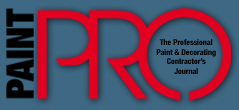
Drywall Texture
Hand Texture Finishes, Drywall Mud, Spanish Lace, French Lace. There's a growing interest in applied textures on walls and ceilings spells opportunity for painting contractors.
by Susan Brimo-Cox
, and remodeling and decorating magazines, a growing interest in applied textures on walls and ceilings spells opportunity for painting contractors.
“The look definitely gives character,” observes Jimmy Gutierrez, sales manager and trainer for Benron Equipment & Supply Co. in Mission Hills, Calif. “It allows the colors to stand out better. You see a stipple instead of a flat wall.”
Texturing walls and ceilings isn’t very difficult — in fact, it’s pretty straightforward. However, it is an art, lending itself to creative experimentation. So, for professional painters, it should be a natural fit.
As Kent Annis, president of Full Circle International Inc. in Burnsville, Minn., points out, “Painters are usually artistic and it’s right up their alley.”
But customer preferences vary. “The popularity for texture is as diverse as any building fad I have witnessed,” Annis says.
Popcorn is probably the most well-known texture. Also known as acoustic, popcorn is a heavy texture that is normally used on ceilings. It is good at hiding imperfections and helps to deaden sound.
Jeff Maron, vice president of Stone Service Spray Painting in New York City, explains, “The popcorn is latex paint mixed with Styrofoam particles and sprayed in a floor hopper gun or in a handheld hopper. The tips are very large openings designed to flood the surface.”
The demand for popcorn texture depends a lot on the region of the country and the application.
In his metropolitan area, Maron reports popcorn being used in residential co-op hallways and in large, loft-space office facilities where bad ceilings present a challenge. But it is not in great demand, he says.
Annis sees popcorn used to texture ceilings in multifamily, starter and tract homes, “because it’s less labor intensive and cheap.”
Popcorn does cover a lot of ills, but it is difficult to paint and it collects dirt.
Splatter texture, like popcorn, is excellent for hiding imperfections and not very labor intensive. It can be used on walls as well as ceilings.
The lightest splatter texture is described by Gutierrez as a “fog coating.” When applying, it requires a lot of air and the very bare minimum of material. “It is so light you can barely see it, but it gives a bit of stippling,” he explains.
One of the more popular splatter textures is called orangepeel. It, too, is created by applying a fine spray of texture dots by using high air pressure, a small nozzle opening and thin material. The finished texture looks just as the name implies: like the peel of an orange.
By adjusting the pressure, nozzle opening and thickness of the texture material, you can achieve medium to heavy splatter textures. At this end of the spectrum, Gutierrez says, “the stipple will vary with every application due to viscosity and adjustment.”
Splatter textures can also be applied with a roller or splattered on using a long bristle brush, but the texture may not have the consistent appearance you get using a sprayer.
Knockdown texture is probably the most popular texture across the country. It also can be used on ceilings and walls. Annis sees it being used a lot in mid- to high-end single-family homes.
Also called skiptrowel, knockdown texturing requires a thicker texture material, lower air pressure, a larger nozzle and slower application. This allows larger blobs of texturing material to build on the surface. Then, as the texture begins to dry, a wide blade spackle knife or trowel is used to knock down the high spots, creating flat areas.
You can achieve many different looks using the knockdown technique — from light to heavy texture — by varying the air pressure of the sprayer, the thickness of the texture material, the nozzle opening and the pressure used to knock down the peaks. |

